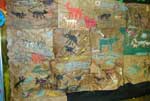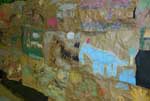Cave Painting Reproductions
by Jay Anderson
Forestville School
|
|
|
|
|
Click
on image for larger view
|
Subject: Social Studies,
Art
Grade: 6
Description: Students
will individually create a reproduction of Cro-Magnon cave paintings, such
as those found at Lascaux.
Objectives: Students
will gain appreciation of the advanced Cro-Magnon culture represented by artistic
depictions of the hunter-gatherer society. Students will broaden their concept
of "cavemen" by discussing and attempting to duplicate the works
of these ancient artists.
This project supports California
History Standard 6.1 - "Students will describe what is known through
archaeological studies of the early physical and cultural development of humankind
from the Paleolithic era to the agricultural revolution."
This project supports California
Art Standard 3.0 - "Students analyze the role and development of the
visual arts in past and present cultures throughout the world, noting human
diversity as it relates to the visual arts and artists."
This project supports California
Art Standard 4.0 - "Students analyze, assess, and derive meaning from
works of art, including their own, according to elements of art, principles
of design, and aesthetic qualities."
Supplies:
Preparation: Cut paper
bags in half creating two large flat pieces (no writing on one side)
Divide the chalk pieces into containers that can be easily shared and contain
a variety of colors.
Time Needed: Approximately
one hour
Procedure:
- Discuss the cave art of the Cro-Magnon people with the class. Show examples
of the art form from text and art books. Point out techniques of form and
shading. Ask students why the paintings included the particular subjects
and themes. Ask what the purposes of the paintings were. Discussion should
include good luck for hunts, attracting animals to the hunting grounds,
pleasing the spirits, and beautifying the cave.
- Tell students they will be reproducing Cro-Magnon cave art, using techniques
similar to what the Cro-Magnons used.
G
- ive each student a piece of the brown paper and have them crumple the
paper into a tight ball. Tell the students to hold the ball to their heart,
close their eyes, and put their intentions into the ball of paper (i.e.
good luck for a hunt, magic to draw animals into the area, offerings to
please the spirits, or beauty to improve life in the cave).
- Have students open the paper and flatten it back into a sheet. Explain
that this rough texture represents the rough cave walls and ceiling. Remind
students that the cave people drew on the walls and ceiling, but not the
floor. Tell them they must do the same, so they must tape the paper to a
wall or the underside of a desk or table. They must stand, squat, or lay
down while drawing - no sitting in chairs. Of course, mobility impaired
students may be exempted from the no sitting rule.
- As students are taping their paper to a wall or underside of desks and
tables, pass out the containers of colored chalk. It may help to have students
work near each other and share the chalk.
- Give students adequate time to complete their cave art. Circulate and
assist if needed.
- When complete, students should write their names on the back of the paper
in pencil or pen.
Display: The finished
product can be displayed individually, or mounted side by side on a wall to
create a large scale scene. Stapling to a bulletin board can allow the teacher
to create three-dimensional bulges reminiscent of rough cave walls.
back
© Deborah Padrick 2003


